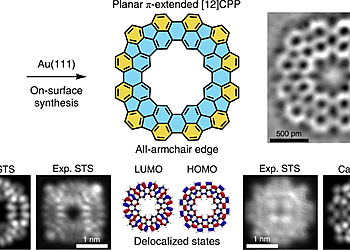Planar π-Extended Cycloparaphenylenes Featuring an All-Armchair Edge Topology
Result of the Month
In this Article, we report the successful bottom-up synthesis and electronic properties of planarized π-extended [12]CPP along with bent armchair graphene nanoribbons (GNRs) and [15]CPP-based macrocycles on Au(111). The experiments were performed using combined scanning tunnelling microscopy (STM) and non-contact atomic force microscopy (nc-AFM) in ultrahigh vacuum at T = 4.8 K and are complemented by density functional theory (DFT) calculations. The planar π-extended CPP is a nanographene featuring an all-armchair edge topology with solely para-connected phenylene units at the periphery. The strong electronic communication along an extended π-system due to the para-conjugation leads to delocalized states around the entire ring. In this way, the planarization maximizes the overlap of p orbitals. Calculations predict global aromaticity and ring currents in charged species, making them quantum rings with unprecedent application opportunities.

Fig. 2 | On-surface synthesis of the planar π-extended [12]CPP and related structures. a, Chemical structures of precursors 1 and 2. b, Overview STM image of 1 upon adsorption on Au(111) at 570 K. c, High-resolution STM images and structures of the main reaction products of 1 and 2 after annealing above 510 K on Au(111). The scan parameters in b and c are as follows: U = −1 V, I = 100 pA. Scale bar, 20 nm (b); U = 0.5 V, I = 40 pA (chain 1); U = −0.9 V, I = 200 pA (chain 2); U = 5 mV, I = 20 pA (trimer); U = −0.1 V, I = 60 pA (tetramer); U = −5 mV, I = 60 pA (pentamer). Scale bar, 1 nm (c).
Experimental. The Au(111) single crystal (MaTeck) was cleaned by several cycles of argon ion sputtering and annealing (~750 K). The molecules were thoroughly degassed before deposition, and the evaporation rates were calibrated with a quartz microbalance. Precursors 1 and 2 were deposited from a quartz crucible heated at 440 K (1) and 475 K (2), while the sample was kept at 300 K, 450 K or 570 K during deposition, as specified in the figure captions. Upon annealing at 570 K, the residual Br is desorbed from the Au(111) surface and the herringbone construction is restored.
STM and nc-AFM measurements were carried out in an ultrahigh-vacuum system with a base pressure better than 1 × 10−10 mbar. A Scienta Omicron STM/nc-AFM system in a separate chamber was used to perform the experiments at T = 4.8 K. A qPlus tuning fork sensor (k = 1,800 Nm−1, f0 ≈ 24,878 Hz, Q ≈ 14,400) with an etched tungsten tip was used. Constant-height STM and nc-AFM images were acquired with a CO-functionalized tip. The weakly adsorbed CO was picked up by scanning with I = 30 pA and U ≤ 30 mV over a CO molecule on Au(111).

Fig. 3 | Chemical structure of the planar π-extended [12]CPP (tetramer) and bent armchair GNR (trimer). a, Constant-height overview STM image of 1 upon adsorption on Au(111) kept at 570 K. b,c, Detailed constant-height Laplace-filtered nc-AFM image of a tetramer (b) and STM image of a trimer (c) measured with a CO-functionalized tip, and the corresponding DFT-optimized structures on Au(111) (right). d,e, Gas-phase calculations of different configurations of the tetramer (d) and trimer (e). Scale bars, 1 nm. Scan parameters: U = 5 mV, I = 30 pA (a); U = 5 mV, I = 20 pA (b,c), before turning off the feedback.

Fig. 4 | Electronic structure of the planar π-extended [12]CPP. a, Characteristic dI/dV point spectra acquired at the positions shown in the inset STM image (coloured dots). b, Calculated DOS on Au(111). c–e, Experimental (with CO-functionalized tip) (c) and calculated dI/dV maps using a p-wave tip (d) and mixed sp-wave (e) in constant height mode. We note that PBE underestimates the energies. Scan parameters: I = 600 pA, U = 0.92 V (a). I = 600 pA. The bias voltage is shown on top of each map (c). Scale bars (inset and dI/dV maps), 1 nm.

